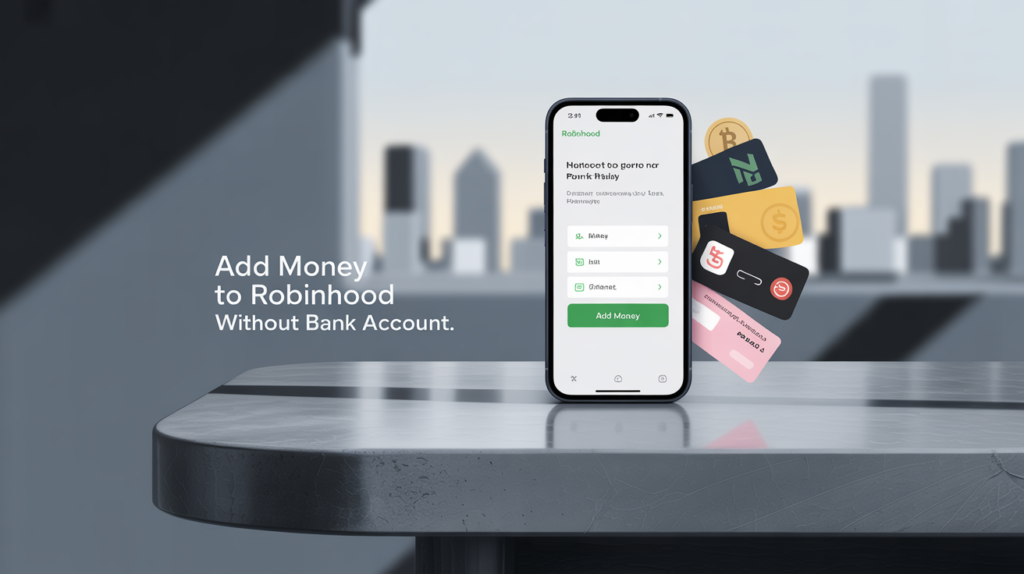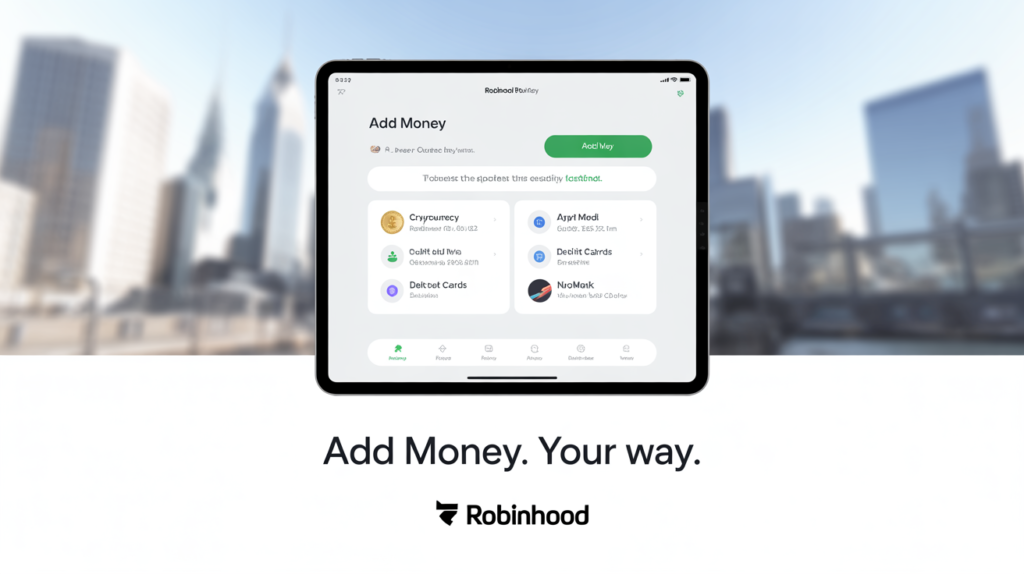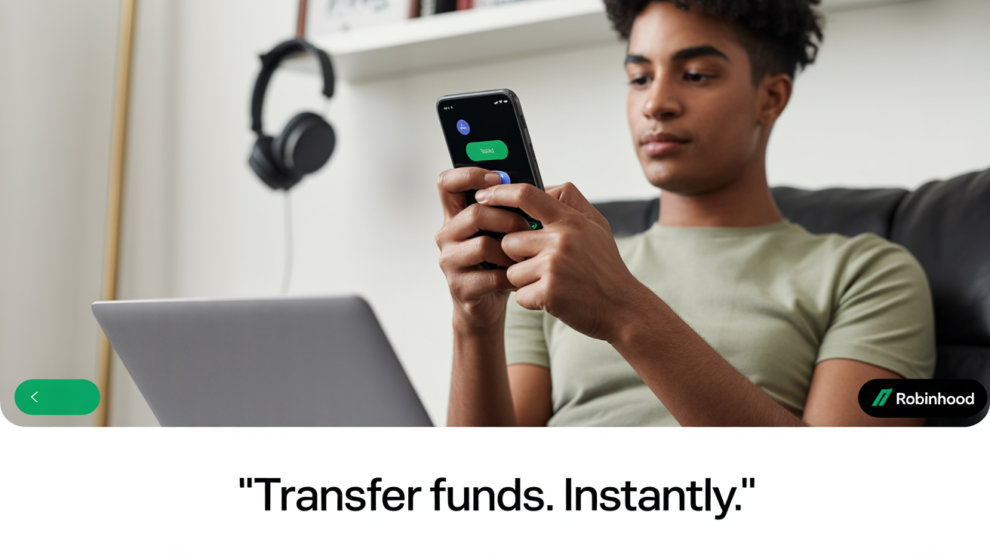Want to start investing on Robinhood but don’t have a bank account? Discover simple ways to add money to Robinhood without bank account and kickstart your trading journey!
Table of Contents
Robinhood has revolutionized the world of personal finance by offering a commission-free trading platform that empowers everyone to invest in stocks, exchange-traded funds (ETFs), options, and cryptocurrencies. With its user-friendly interface and no minimum balance requirements, it’s no wonder millions have flocked to the app since its launch in 2015.
However, one common challenge for new users, especially those without a U.S. bank account, is figuring out how to fund their Robinhood account to start trading. Whether you’re unbanked, prefer not to link a bank account for privacy reasons, or simply want alternative funding methods, this guide is for you.
In this 3,000-word blog post, we’ll explore what Robinhood is, why you might want to add money without a bank account, the methods to do so, their advantages and disadvantages, practical tips, and answers to common questions. By the end, you’ll have a clear roadmap to fund your Robinhood account and begin your investing journey with confidence.
What is Robinhood?
Robinhood is a financial services platform designed to democratize investing. Founded in 2015 by Vladimir Tenev and Baiju Bhatt, the Menlo Park, California-based company offers commission-free trading through its mobile app and website. Users can trade stocks, ETFs, options, and select cryptocurrencies like Bitcoin and Ethereum without paying traditional brokerage fees. Robinhood also provides a spending account and a Robinhood Cash Card (a Visa debit card issued by Sutton Bank), which allows users to manage non-investment transactions like everyday purchases or ATM withdrawals. The platform’s accessibility, with no minimum deposit and an intuitive design, makes it ideal for beginners and seasoned investors alike.
Key Features of Robinhood
- Commission-Free Trading: Trade stocks, ETFs, options, and crypto without paying per-trade fees, a game-changer in the brokerage industry.
- No Minimum Balance: Start investing with as little as $1, making it accessible for those with limited funds.
- Robinhood Cash Card: A customizable debit card linked to a spending account, usable anywhere Visa is accepted.
- Fractional Shares: Buy fractions of expensive stocks (e.g., $10 of Amazon stock), enabling diversified portfolios on a budget.
- Instant Deposits: Eligible users can access funds immediately for trading, even before they settle.
- FDIC Insurance: Cash in your spending account is insured up to $250,000 through partner banks like JPMorgan Chase or Goldman Sachs.
- Educational Resources: Robinhood Learn offers articles and videos to help users understand investing basics.
Robinhood’s mission to “democratize finance for all” has made it a popular choice, but funding your account is the first step to unlocking its potential. For those without a bank account, alternative methods are essential to participate in this financial ecosystem.
Why Add Money to Robinhood Without a Bank Account?

Adding funds to your Robinhood account is necessary to start trading or using the Robinhood Cash Card for purchases. While linking a bank account is the most common method, many users prefer or need alternatives. Here are some reasons why you might want to add money without a bank account:
- Lack of Access to Banking: Approximately 4.5% of U.S. households (5.9 million) were unbanked in 2021, according to the FDIC, meaning they lack a checking or savings account.
- Privacy Concerns: Some users hesitate to share bank details due to security fears or past experiences with data breaches.
- Poor Credit History: Individuals with credit issues may struggle to open a traditional bank account, making alternatives like debit or prepaid cards more viable.
- International Users: Non-U.S. residents or those with non-U.S. bank accounts may face challenges linking accounts to Robinhood, which requires U.S.-based accounts.
- Convenience: Using a debit card or third-party service may feel faster or more familiar for some users.
By exploring alternative funding methods, you can bypass these barriers and start investing or spending with Robinhood. These methods offer flexibility but come with unique considerations, which we’ll cover in detail.
Methods to Add Money to Robinhood Without Bank Account
Robinhood primarily encourages bank account linking for deposits, but several workarounds allow you to fund your account without one. Below are the primary methods, complete with step-by-step instructions and practical insights.
1. Use a Debit Card
Robinhood accepts Visa or Mastercard debit cards (issued by U.S. banks) for instant or standard deposits, making this a fast and accessible option for funding your account.
Steps:
- Open the Robinhood app on your iOS or Android device.
- Tap the Account icon (person icon) in the bottom-right corner (iOS) or top-right corner (Android).
- Navigate to Transfers > Linked Accounts > Add Account.
- Select Debit Card and enter the card’s details: card number, expiration date, CVC, and billing ZIP code.
- Robinhood will place a temporary $1.95 hold on your card to verify it. Check your card statement (online or via your bank’s app) for a 6-digit verification code starting with “RH*.”
- Enter the code in the Robinhood app to complete verification (the $1.95 is refunded after verification).
- Once verified, go to Transfers > Transfer Money.
- Select your debit card in the “From” field and your Robinhood brokerage or spending account in the “To” field.
- Enter the desired amount and choose Instant Transfer (2.5% fee, funds available immediately) or Standard Transfer (free, takes 3–5 business days).
- Review and submit the transfer. You’ll receive a confirmation in the app.
Key Considerations:
- Eligibility: Debit cards must be issued by a U.S. bank. Non-U.S. cards or prepaid cards may not support instant transfers.
- Limits: Instant deposit limits vary (e.g., $1,000–$5,000/day for new accounts, up to $50,000/day for verified accounts). Check Transfers > Transfer Limits in the app.
- Fees: Instant transfers incur a 2.5% fee (e.g., $2.50 on a $100 deposit). Standard transfers are free.
- Processing Time: Instant transfers are available immediately for trading; standard transfers take 3–5 days to settle.
2. Use a Prepaid Debit Card
Prepaid debit cards, such as those from Netspend, Green Dot, or Walmart MoneyCard, can be loaded with cash at retailers and used to fund Robinhood, though only for standard transfers.
Steps:
- Purchase a prepaid debit card at a retailer like Walmart, CVS, or 7-Eleven. Load it with cash or another funding source (e.g., at the store’s register).
- In the Robinhood app, go to Account > Transfers > Linked Accounts > Add Account.
- Enter the prepaid card’s details (card number, expiration date, CVC, ZIP code).
- Verify the card by locating the $1.95 temporary charge and 6-digit “RH*” code on your card statement (check online or contact the card issuer).
- Enter the verification code in the Robinhood app.
- Go to Transfers > Transfer Money, select the prepaid card, and enter the amount.
- Choose Standard Transfer (instant transfers are not supported for most prepaid cards).
- Submit the transfer. Funds will be available in your Robinhood account in 3–5 business days.
Key Considerations:
- Fees: Prepaid cards may have activation, loading, or transaction fees (e.g., $1–$5 to load cash). Check with the card provider.
- Limits: Prepaid card deposits are typically capped at $1,000/day or lower, depending on the card and Robinhood’s limits.
- Restrictions: Not all prepaid cards are compatible with Robinhood. Ensure the card is Visa or Mastercard and issued by a U.S. financial institution.
- Processing Time: Only standard transfers are available, taking 3–5 days.
3. Use Third-Party Payment Processors (Indirectly)
Third-party services like PayPal, Venmo, or Cash App can act as intermediaries. You can load funds into these platforms (via cash, debit card, or prepaid card) and transfer them to a debit card, which can then be used to fund Robinhood.
Steps (Using Cash App as an Example):
- Download and set up a Cash App account if you don’t have one.
- Fund your Cash App account:
- Cash Deposit: Visit a retailer like Walmart or 7-Eleven, select Paper Money in Cash App, show the barcode, and deposit cash ($1–$4 fee).
- Debit/Prepaid Card: Link a debit or prepaid card to Cash App and transfer funds.
- Transfer the funds from Cash App to a linked debit card (1.5% fee for instant transfers, free for standard 1–3 day transfers).
- In the Robinhood app, link the same debit card (as described in Method 1).
- Go to Transfers > Transfer Money, select the debit card, and enter the amount.
- Choose Instant Transfer (2.5% fee) or Standard Transfer (free, 3–5 days).
- Submit the transfer and confirm.
Key Considerations:
- Fees: Cash App charges 1.5% for instant transfers to a debit card, and retailers may charge $1–$4 for cash deposits. Robinhood’s 2.5% instant transfer fee may also apply.
- Complexity: This method involves multiple steps and platforms, increasing the risk of errors.
- Processing Time: Cash App transfers to a debit card can be instant or take 1–3 days; Robinhood deposits take an additional 0–5 days depending on transfer type.
- Compatibility: Ensure the debit card linked to both platforms is compatible with Robinhood.
4. Receive Money from Friends or Family
You can ask a trusted friend or family member to send funds to your Robinhood spending or brokerage account using their bank account, debit card, or Robinhood account.
Steps:
- Open a Robinhood spending account (if not already active) via Spending > Settings in the app.
- Find your account and routing numbers in Spending > Settings > Account & Routing Numbers (for spending account) or Transfers > Account Details (for brokerage account).
- Share these details with a trusted sender, or use Robinhood’s Pay & Request feature if they’re a Robinhood user.
- The sender can transfer funds via:
- Their bank account (using your routing/account numbers).
- A debit card linked to their Robinhood account.
- Robinhood’s Pay & Request feature (instant, no fees between Robinhood users).
- Funds received in your spending account can be moved to your brokerage account instantly (up to $500,000/day) via Transfers > Move Money Between Accounts.
Key Considerations:
- Trust: Only share account details with trusted individuals to avoid scams.
- Processing Time: Bank transfers from the sender may take 3–5 days; Robinhood-to-Robinhood transfers are instant.
- Limits: Spending account deposits are limited to $50,000/day for verified accounts.
- Availability: Funds in the spending account can be used with the Robinhood Cash Card or transferred to the brokerage account for trading.
Advantages of Adding Money Without a Bank Account

These alternative methods offer several benefits for users who can’t or won’t link a bank account:
- Accessibility for the Unbanked: Enables the 4.5% of U.S. households without bank accounts to participate in investing.
- Privacy Protection: Avoid sharing sensitive bank details, appealing to those concerned about data security.
- Flexible Funding Options: Debit cards, prepaid cards, and third-party apps provide multiple ways to load funds.
- Speed for Debit Cards: Instant debit card transfers (with a 2.5% fee) allow immediate trading, ideal for seizing market opportunities.
- No Minimums: Robinhood’s $0 minimum deposit means you can start with small amounts, even $1.
- Widespread Availability: Prepaid cards and third-party services are available at thousands of retailers nationwide.
Disadvantages of Adding Money Without a Bank Account
While these methods are convenient, they come with limitations:
- Fees: Instant debit card transfers cost 2.5% (e.g., $2.50 on $100). Third-party apps like Cash App charge 1.5% for instant transfers, and retailers may add $1–$4 for cash deposits.
- Lower Deposit Limits: Prepaid cards and some debit cards are capped at $1,000–$5,000/day, compared to $50,000/day for bank accounts.
- Processing Delays: Standard transfers take 3–5 days, which can delay trading compared to instant bank transfers.
- Complexity: Using third-party apps involves multiple platforms, increasing the risk of errors or delays.
- Verification Issues: Some debit or prepaid cards may fail Robinhood’s $1.95 verification process if the issuer flags the charge.
- Scam Risks: Accepting funds from untrusted sources (e.g., strangers offering payments) can expose you to scams. Always verify senders.
- Limited Support: Robinhood’s customer service is primarily app-based, which may be slow for resolving complex deposit issues.
Tips for a Smooth Experience
To ensure a seamless process when adding money without a bank account, consider these practical tips:
- Verify Cards Quickly: Check your debit or prepaid card statement (online or via the issuer’s app) for the $1.95 charge and “RH*” code immediately after linking.
- Compare Fees: Calculate total costs (e.g., retailer fees, third-party transfer fees, Robinhood’s 2.5% instant fee) to choose the most cost-effective method.
- Check Limits: Go to Transfers > Transfer Limits to confirm your daily/weekly deposit caps, which vary based on account verification and funding source.
- Avoid Scams: Never accept unsolicited payments or share account details with unknown individuals. Report suspicious activity to Robinhood via Account > Help > Contact Support.
- Use a Secure Device: Ensure your phone or computer is secure (updated software, strong passwords) when entering card details.
- Plan for Delays: For standard transfers, allow 3–5 days for funds to settle, especially if you’re timing the market.
- Enable Notifications: Turn on push or email notifications in the Robinhood app to track deposits and transfers.
- Verify Your Identity: Submit your Social Security number or ID to increase deposit limits and unlock features like instant deposits.
- Test Small Amounts: Start with a small deposit (e.g., $10) to ensure the method works before transferring larger sums.
What to Expect When Adding Money
Understanding the logistics of these methods helps set realistic expectations:
- Processing Time: Instant debit card transfers are available within minutes (with a 2.5% fee). Standard transfers (debit or prepaid cards) take 3–5 days. Third-party app transfers depend on their processing times (e.g., Cash App’s 1–3 days to a debit card).
- Deposit Limits: Limits vary by method: $1,000–$5,000/day for debit/prepaid cards, up to $50,000/day for spending account deposits. Check Transfers > Transfer Limits for your account’s specifics.
- Availability for Trading: Instant deposits can be used immediately for trading, but withdrawing funds requires a 5-day settlement period. Standard deposits are available for trading once settled (3–5 days).
- Security Measures: Robinhood uses encryption, two-factor authentication (2FA), and fraud detection to protect transactions. Always use a secure Wi-Fi network and keep your app updated.
- FDIC Insurance: Funds in your Robinhood spending account are insured up to $250,000 through partner banks (e.g., JPMorgan Chase, Goldman Sachs). Brokerage account funds are SIPC-insured up to $500,000 for securities and $250,000 for cash.
- Confirmation: You’ll receive in-app or email notifications once funds are deposited or if there’s an issue (e.g., failed verification).
FAQs
1. Can I use a credit card to add money to Robinhood?
No, Robinhood does not accept credit cards for deposits. You can use a U.S.-issued Visa or Mastercard debit card, prepaid debit card, or third-party payment processors like Cash App or PayPal (indirectly).
2. Are there fees for adding money to Robinhood without a bank account?
Yes, instant debit card deposits incur a 2.5% fee (e.g., $2.50 on $100). Standard transfers are free but take 3–5 days. Third-party apps (e.g., Cash App) may charge 1.5% for instant transfers, and retailers may add $1–$4 for cash deposits.
3. How long does it take for funds to appear in my Robinhood account?
Instant debit card transfers are available within minutes. Standard transfers via debit or prepaid cards take 3–5 business days. Third-party app transfers depend on their processing times (e.g., 1–3 days to a debit card, plus Robinhood’s processing).
4. Can I deposit cash directly into Robinhood at a retailer?
Robinhood does not offer direct cash deposits at retailers. Instead, deposit cash into a third-party app like Cash App at a retailer (e.g., Walmart), transfer to a debit card, and then fund your Robinhood account.
Conclusion
Adding money to Robinhood without a bank account is not only possible but also flexible, thanks to methods like debit cards, prepaid cards, third-party payment processors, and transfers from trusted friends or family. These alternatives make Robinhood accessible to the unbanked, privacy-conscious, or those without U.S. bank accounts, allowing anyone to participate in commission-free trading. While these methods offer convenience and speed (especially with instant transfers), they come with potential fees, lower limits, and longer processing times compared to bank transfers. By following the detailed steps, weighing the advantages and disadvantages, and applying the practical tips provided, you can fund your Robinhood account efficiently and securely. Whether you’re buying your first stock, exploring crypto, or using the Robinhood Cash Card, these funding options empower you to take control of your financial future. Start today by choosing the method that best suits your needs and dive into the world of investing with Robinhood!
Do Follow Dragcast on Social Media For More Such Content.






Add Comment